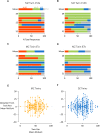A Laboratory Study of the McGurk Effect in 324 Monozygotic and Dizygotic Twins
- PMID: 31636529
- PMCID: PMC6787151
- DOI: 10.3389/fnins.2019.01029
A Laboratory Study of the McGurk Effect in 324 Monozygotic and Dizygotic Twins
Abstract
Multisensory integration of information from the talker's voice and the talker's mouth facilitates human speech perception. A popular assay of audiovisual integration is the McGurk effect, an illusion in which incongruent visual speech information categorically changes the percept of auditory speech. There is substantial interindividual variability in susceptibility to the McGurk effect. To better understand possible sources of this variability, we examined the McGurk effect in 324 native Mandarin speakers, consisting of 73 monozygotic (MZ) and 89 dizygotic (DZ) twin pairs. When tested with 9 different McGurk stimuli, some participants never perceived the illusion and others always perceived it. Within participants, perception was similar across time (r = 0.55 at a 2-year retest in 150 participants) suggesting that McGurk susceptibility reflects a stable trait rather than short-term perceptual fluctuations. To examine the effects of shared genetics and prenatal environment, we compared McGurk susceptibility between MZ and DZ twins. Both twin types had significantly greater correlation than unrelated pairs (r = 0.28 for MZ twins and r = 0.21 for DZ twins) suggesting that the genes and environmental factors shared by twins contribute to individual differences in multisensory speech perception. Conversely, the existence of substantial differences within twin pairs (even MZ co-twins) and the overall low percentage of explained variance (5.5%) argues against a deterministic view of individual differences in multisensory integration.
Keywords: McGurk effect; audiovisual fusion; behavioral genetics; multisensory integration; twin studies.
Copyright © 2019 Feng, Zhou, Zhou, Beauchamp and Magnotti.
Figures


References
Grants and funding
LinkOut - more resources
Full Text Sources

